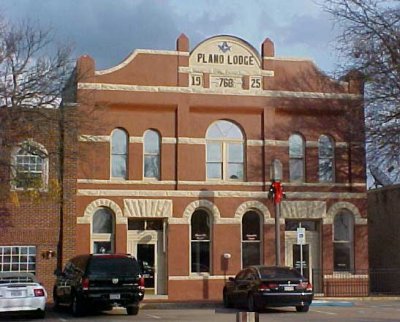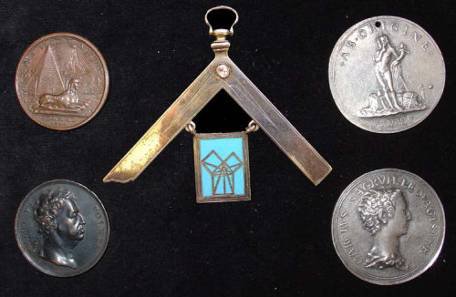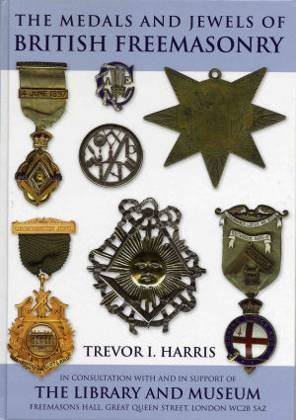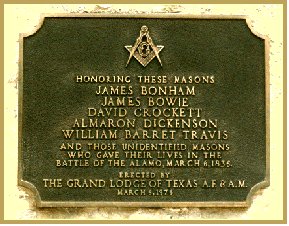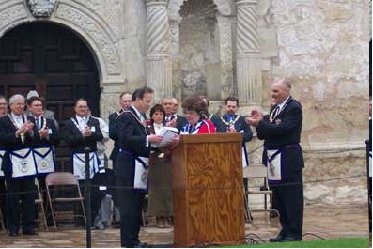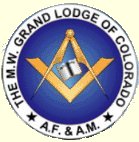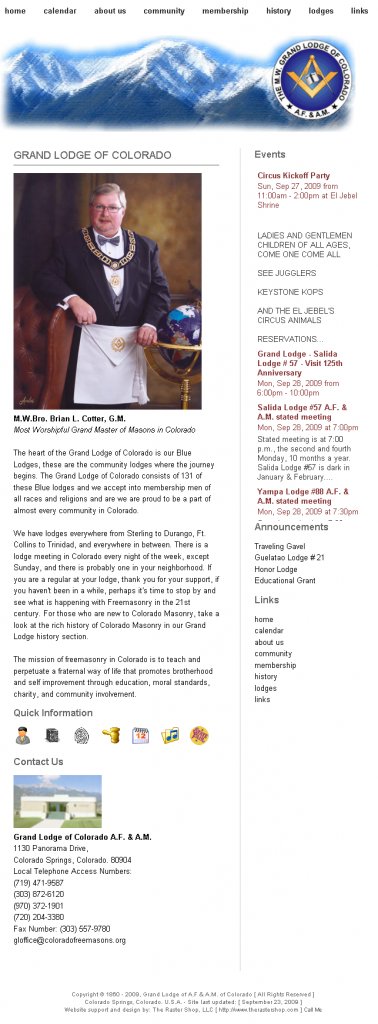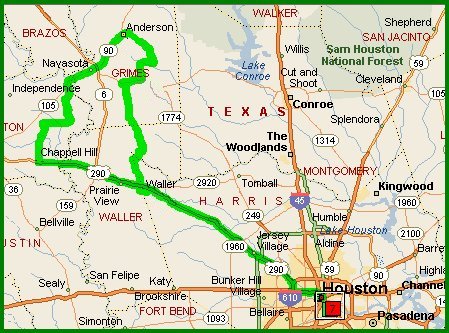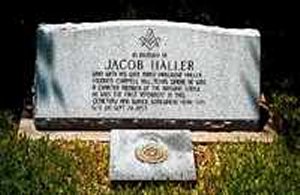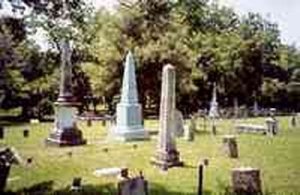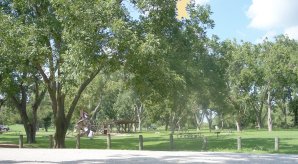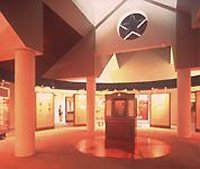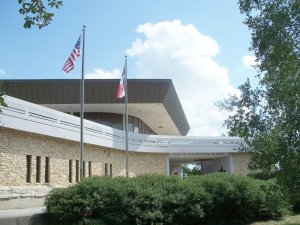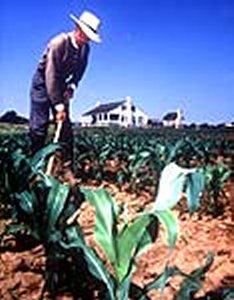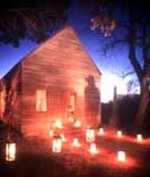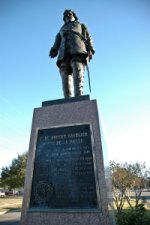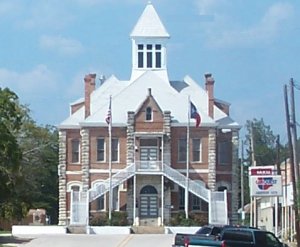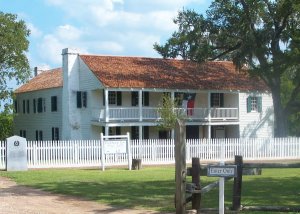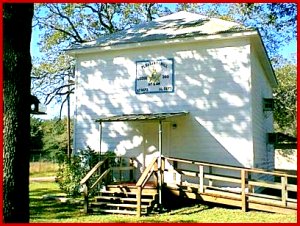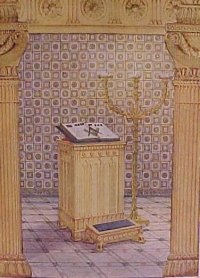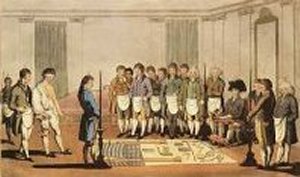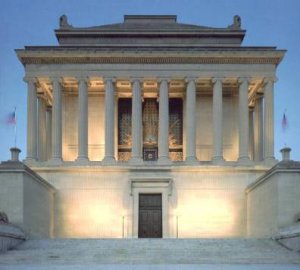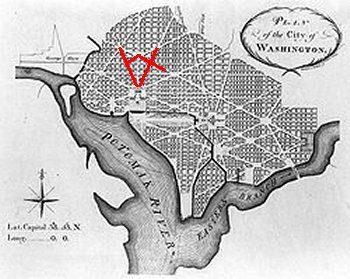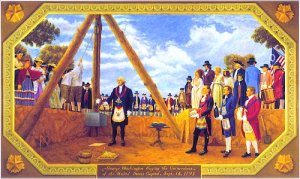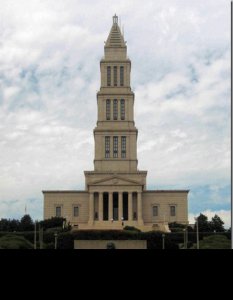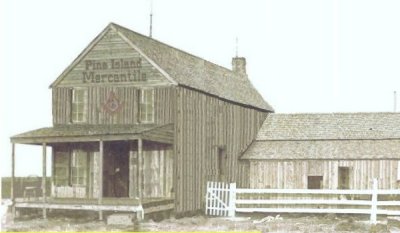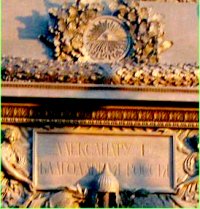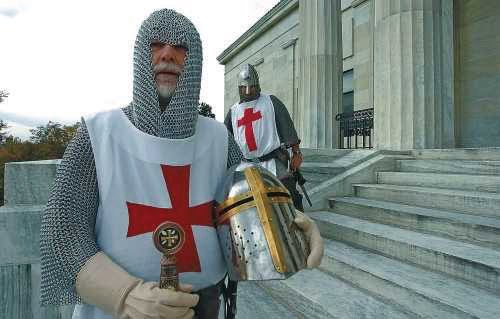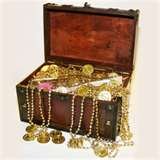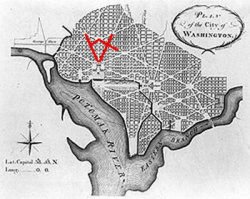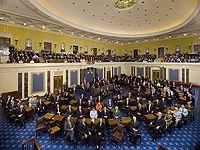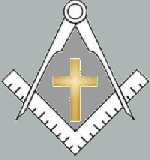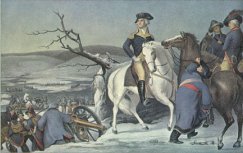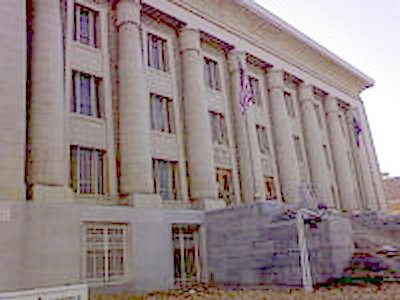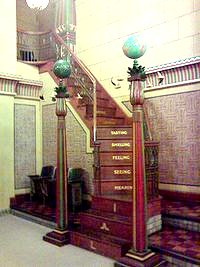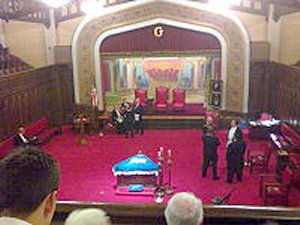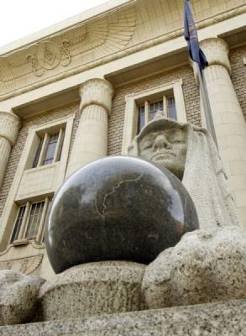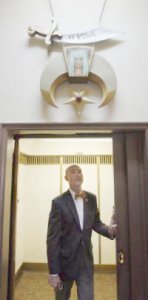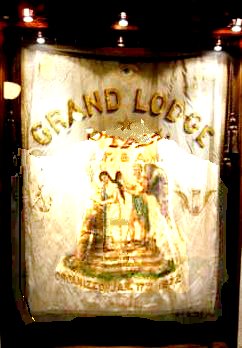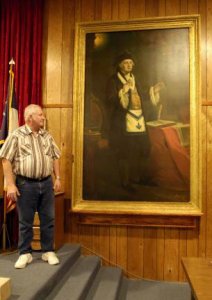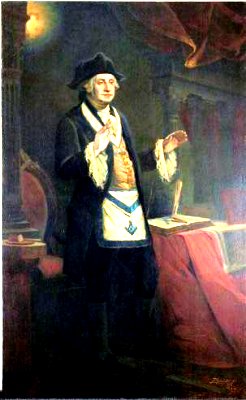
|
November 2009

Plano Lodge #768 A. F. & A. M.
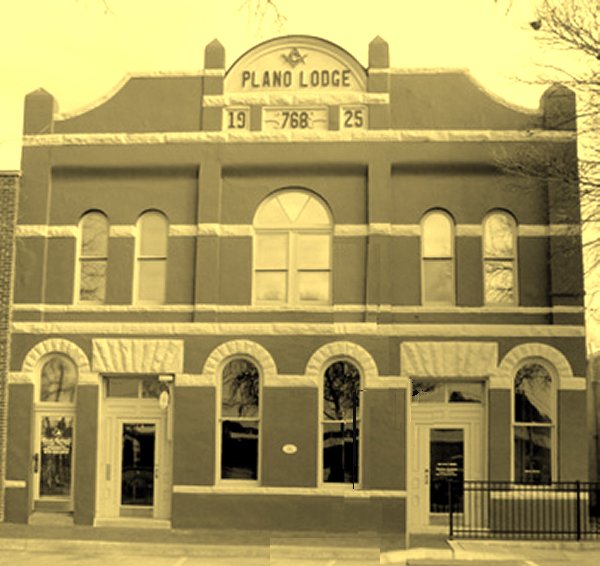 The Plano Lodge #768 A. F. & A. M. in Plano, Texas |
|
Page III | |
From the Plano Lodge Web Site The Early Lodges
Masonry was not far behind in the North Texas area. The first lodge chartered in this area was DeKalb Lodge No. 9 in DeKalb, Bowie County on 2 February 1840. DeKalb Lodge No. 9 demised in 1844, but was rechartered in 1892 with the same lodge number. Dr. Daniel Rowlett, a large landowner in the Plano area, helped organize Constantine Masonic Lodge No. 13 at old Warren, now Bonham, on 18 March 1840 and was its first Worshipful Master. Friendship Lodge No. 15 in Clarksville, Red River Co., was chartered 11 December 1841. Paris Lodge No. 27, Lamar Co, was chartered 24 January 1845. St. Johns Lodge No. 51 in McKinney, Collin Co., was chartered 24 January 1850. Tannehill Lodge No. 52, Dallas Co., was chartered 24 January 1850. Boston Lodge No. 69, New Boston, Bowie Co., was chartered 24 January 1851. Manta Lodge No. 209, Van Alstyne, Grayson Co., was chartered 22 June 1858. Farmersville Lodge No. 214, Collin Co., was chartered 19 January 1858. White Rock Lodge No. 234 in Addison, Dallas Co., was chartered 16 June 1859. Plano Lodge No. 235, Collin Co., was set to work under dispensation 15 June 1858, chartered 17 June 1859 and demised during the year of 1888. Plano Lodge No. 235's charter officers consisted of Dr. James Wilson, WM, a physician who arrived in Plano from Tennessee in 1859, George W. Barnett, S.W., who came to Collin Co. in 1843, and George R. Yantis, J.W., whose origin is unknown. Other original members of the lodge were W. S. Coffey, James C. Fain, Robert Fitzugh, Dewitt C. Forman, William Forman, James C. Forman, George W. Givens, J. C. Givens, N. Givens, J. E. Harrison, William C. McKamy, B. E. Pegues, J. G. Vance, F. J. Vance, Samuel M. Wilkins, and B. N. Wilkins. Other distinguished members included Captain William Beverly, William B. Blalack, Dr. Henry Dye, Thomas F. Hughston, William M. Weaver, James Wells, and R. B. Whisenant. The first meeting place is assumed to be in a building on the George W. Barnett farm, located near the banks of Spring Creek and a fresh water spring. This building served for the school, church, and other fraternal meetings like the Plano Masonic Lodge. The second meeting place for the lodge was located over the storehouse built by James C. Forman and Hampton H. Gossum on the southeast corner of Avenue K and 15th Street. The agreement between Forman and Gossum and the Plano Masonic Lodge was to give “the Masons the privilege of building a Masonic Hall or other building on top of the storehouse” for the use and benefit of the Masonic fraternity forever.” The lodge is believed to have built and moved into this building sometime in 1860. Fires plagued Plano during the 1880's and 1890's. The lodge building was destroyed by fire in July or August of 1881. The first called meeting after the Lodge building was destroyed, was held on 7 September in the Baptist Church in Plano to devise plans for rebuilding a Hall and disposing of lodge property. The stated meeting of 1 October 1881 was held on the second floor of the Chaddick & Housewright building located on the northwest corner of Avenue K and 15th Street, known in later years as the Harrington Furniture Store. The 1st floor of the building was operated as a saloon and the lodge met above it. This stated meeting's primary purpose was to procure a suitable place for the Lodge to meet and, also, to procure Lodge Jewels, a seal, record books, and other lodge regalia. Subsequent stated meetings dealt with procurement of lodge furniture and the purchase of a lot on which to rebuild the lodge. The Emerson lot was approved for the purchase price of $500 in April, 1882. The committee reported in July that the property had been purchased with $100 down and the remainder to be paid in twelve months. A committee was appointed in April to develop plans and to estimate the cost of the new building. The committee reported at the May meeting that a building 25' x 60' x 24' high would cost about $1700. Bids for the building were solicited and the low bid of $1893.75 was received from James L. Glorence & Co. This bid was approved by the lodge on 18 November 1882 with instructions to proceed with its construction. Apparently the building was nearing completion, because at the 19 May 1883 stated meeting a committee composed of Brothers J. T. Kendrick, Joe W. Beverly and J.H. Reedy was appointed to rent the store room, or lower floor, of the lodge for no less than $20 per month. The lodge also passed a motion to forbid the storeroom to be used as a drinking saloon or any gaming purposes. The lodge then passed a motion that the building committee be instructed to buy 2 or 3 dozen chairs for the lodge room and Brother J. B. Klepper was appointed to move the furniture into the new lodge room. The lodge continued to meet in the lodge, but the records from Grand Lodge indicate that the lodge charter was arrested in 1887 for failure to meet. However, the minutes of the lodge fail to indicate this occurrence nor does there appear to be a break in the minutes through the year. The last stated meeting of record in the minutes occurred on 21 April 1888. The M.W. Grand Lodge of Texas' records only indicate that the lodge demised in 1888. There is no written record of what happened between April and when the charter was surrendered to the Grand Lodge. Many older members agree that the lodge fell upon hard times for various reasons. The minutes of the lodge indicate a long standing indebtedness to a Brother, but after several attempts to resolve a means of repaying the Brother, the lodge finally resorted to executing a note to the Brother for the sum owed. Also, numerous members were declared in arrears for their dues resulting in charges and specifications being preferred against them. The lodge also experienced numerous demits from the members which lessened its financial base. This was apparently a result of very hard times in the community at that time. We also see in the minutes numerous charges made against members for non-Masonic conduct, for nonpayment of dues, and for public intoxication. (See minutes of 28 January and 25 February 1888 for full details) The membership was very hard on its members to be upstanding citizens of the community. However, many members were determined to continue their Masonic careers and affiliated with White Rock Lodge No. 234, in Addison, which continues to be a viable lodge in the Dallas area. It was located in the southwestern corner of Collin County. The lodge had built a hall in 1872 on property adjoining the Frankford Methodist Church prior to the church purchasing land from William McKamy in 1873. The church actually held its early worship services on the first floor of the lodge building, which was also used for other fraternal, religious, and educational purposes. After some years, a number of Plano masons decided it was again time for Plano to have it's own lodge. The Most Worshipful Grand Lodge was duly petitioned and was granted a charted on 5 December 1894 and was to be known by the name and style of Plano Lodge No. 768, of Ancient Free and Accepted Masons. The Lodge was then Constituted in due and ancient form on 7 January 1895 with Right Worshipful Sam R. Hamilton, Deputy Grand Master, performing the honors during an opening of a Deputy Grand Lodge in the Plano Lodge room. The charter members numbered many former members and officers of Plano Lodge No. 235, such as Dr. James Wilson, the Charter Master, F. R. Ball, Thomas F. Hughston, Joseph H. Gulledge, and William M. Weaver. Other charter members were F. M. Armstrong, E. W. Dinwiddee, M. J. Ford, J. A. Gant, C. S. Haggard, and W. A. Vines, to name only a few of the notable and most recognized of the community leaders. The elected officers for the newly chartered lodge at this first stated meeting were duly installed by Right Worshipful Sam R. Hamilton, Deputy Grand Master.
For the rest of the story, visit the Plano Lodge Web Site |
|
Page IV | |||
Badges, medals and jewels of Freemasonry
The tradition continued in the nineteenth century and extended to associations representing all social
groups including friendly societies with a "working class" membership whose base metal jewels were
stamped from dies in considerable numbers.
The Library and Museum of Freemasonry has a very large collection of Masonic jewels. These include commemorative
issues, signifiers of rank, fundraising pieces and membership jewels for individual lodges and
chapters or Masonic orders. Examples date from the eighteenth century to the twenty first century as new
lodges and chapters commission their own lodge or chapter jewels.
A jewel is often a fine example of
the craft of the medal maker, jeweller
or enameller. A jewel tells many
stories: why was it made?, who
made it?, were there variations in
type? why were there such variations?
who was it made for? For all
these reasons and more jewels have
always fascinated collectors.
There have been a number of books on the subject of Masonic jewels and medals. George Shackles, a Hull
freemason, collector and member of the Numismatic Society of London published his Medals of British
Freemasonry in 1901 illustrated with black and white photographs and drawing on his own collection. This
book includes an interesting historical survey by Chetwode Crawley about collectors of ,and writers about,
Masonic medals. He dates the earliest literary work concerned solely with Masonic medals to the 1840s
when Ernst Zacharias published Numotheca Numismatica Latorum in Dresden. This was illustrated with 48
engravings of medals. In 1851 Dr Johann Merzdorf, Librarian to the Grand Duke of Oldenburg published Die
Denkmunzen der Freimaurerbruderschaft which covers 334 separate pieces. This remained the standard
work of reference until 1880 when William Marvin published Medals of the Masonic Fraternity, Described
and Illustrated in Boston, USA including descriptions of 744 medals and 16 plates of illustrations.
Although all these publications are in the Library and Museum
collection, apart from the latter two publications, the
collector, curator or enthusiast seeking information on
these jewels and medals has, in recent years, had to rely on
long out of print books or on primary research in the collections
at the Library and Museum and elsewhere.
A new publication, The Medals and Jewels of British Freemasonry,
has just been published. It includes very many colour
illustrations and attempts a broad survey of the subject.
The publication is available at the Shop at Freemasons' Hall
or online at www.letchworthshop.co.uk | |||
I'd rather see a Mason than hear one any day!
| |||
|
Page V | ||
by Bro. Dwight Stevens, Chairman, Masonic Education and Service Committee
(printed in The Texas Mason, Spring 1998)  In rooms where priests had prayed, bayonets clashed with Bowie Knives and swords. Musket and cannon fire tore into the Texan defenders. By dawn, all the Texan combatants lay dead. Their sacrifice, on March 6, 1836, would immortalize them as legends, and turn the Alamo grounds into Sacred Ground. Each year more than three million Americans visit the Alamo. For many of the visitors, who gaze with reverence at the paintings and exhibits, the Alamo is more shrine than historic monument. They have come to the Alamo to honor those whose death gave birth to a Republic. Brother William Barrett Travis, Commander of the Alamo garrison, is said to have drawn a line in the sand requesting all who would stay and fight to: "step across the line." He drew that line not only in the sand, but into the hearts and minds of every Texas Mason.
"The spirit of liberty appears to be looking down from it's elevated throne saying: Behold your Brothers: Crockett, Bowie, Travis. They preferred to die a thousand times rather than submit themselves to the tyrants yoke. Their sacrifices are worthy of inclusion in the pages of history. What a brilliant example for others to follow." If you have not had the opportunity to visit the Alamo, please do so at your earliest possible convenience. The Daughter's of the Republic of Texas have lovingly turned the Alamo Mission into a shrine. It remains to this day a shrine to the heroes of Texas liberty. The veneration of the defenders reached a new height in 1939 with the dedication of The Alamo Cenotaph. Towering sixty feet above the Alamo, the monument's theme is: "The Spirit of Sacrifice". Statues of the principal defenders, and the names of all the Texans who died at the Alamo, are carved into the granite foundation. During your visit, you will find that the Alamo is a powerful place. It's a place filled with legends and memories. It's a place we all should go think about our own potential, about what we need to sacrifice so that we can keep the fraternity on the road that those men fought to preserve.
M. Boyd Patterson, Jr., (Grand Master-2003), receiving the Texas Flag from the Daughters of the Republic of Texas. Grand Master Patterson flew this flag during the Goliad, San Jacinto and the Charter Oak Observances. The most famous battle of the Texas Revolution came about in San Antonio at a little mission called the Alamo. On March 6, 1836, one hundred and eighty-seven men under the command of Brother William Barrett Travis were defeated by several thousand Mexican soldiers under Santa Anna. Americans and Texans alike were so enraged by this massacre that the Alamo, like the United States flag and the Statue of Liberty, became another symbol of courage and freedom. On July 4, 1976, the Grand Lodge of Texas placed a bronze marker at the Alamo, honoring the Masons who died there: One of the few who survived the massacre at the Alamo was Mrs. Almaron Dickenson (Suzanna) who had been advised by her husband to display his Masonic apron over herself and the child during and after the battle. Santa Anna saw to her needs and even offered to adopt her child. She declined the offer declaring that she would "crawl and work her fingers to the bone to support the baby, but that she would rather see the child starve than given into the hands of the author of so much horror."
March 6, 1836 - After fighting for 13 days, 3,000 Mexicans defeated 182 Texans at the Alamo. A few days earlier, this message was sent: February 24, 1836,
"Commandancy of the Alamo-
To the people of Texas & all Americans in the world --
I am besieged by a thousand or more of the Mexicans under Santa Anna -- I have sustained a continual Bombardment & cannonade for 24 hours and have not lost a man --
The enemy has demanded a surrender at discretion, otherwise, the garrison are to be put to the sword, if the fort is taken. I have answered the demand with a cannon shot, and our flag still waves proudly from the walls --
I shall never surrender or retreat. Then I call on you in the name of Liberty, of patriotism & everything dear to the American character, to come to our aid, with all dispatch --
The enemy is receiving reinforcements daily & will no doubt increase to three or four thousand in four or five days. If this call is neglected, I am determined to sustain as long as possible & die like a soldier who never forgets what is due to his own honor & that of his country --
VICTORY OR DEATH
William Barrett Travis
P.S. The Lord is on our side --
When the enemy appeared in sight we had not three bushels of corn — We have since found in deserted houses 80 or 90 bushels and got into the walls 20 or 30 head Beeves --
Travis
|
|
Page VI | ||
The Grand Lodge of Colorado
Reprinted With Permission Of The Author
The Grand Lodge of Grand Lodge of Colorado is the next stop on the tour of American Grand Lodges.
Grand Lodge of Colorado Masonic membership:
State population: 4,939,456 as of 2008 (estimated)
Mission Statement:
The mission of Freemasonry in Colorado is to teach and perpetuate a fraternal way of life. That promotes brotherhood and self-improvement. Through education, moral standards, charitable giving and community involvement.
About the Grand Lodge:
On the evening of November 3, 1858, seven Masons, including William M. Slaughter, held an informal meeting in one of those cabins; and throughout the following winter these brethren and others continued to meet from time to time, having in mind the formation of a new Masonic Lodge at Auraria, provided the proper authorization could be obtained from some Grand Lodge… read more.
Some of what I found on my excursion there:
The Grand Lodge of Colorado is a minimalist website with a lot lot of punch. The site is has everything that one would want in a Grand Lodge site, including events listed on the front page, information of how to contact and find them, and an address (message) from the Grand Master. It has a very clear look and feel for what Colorado is known for, and lays out all of its informational content right on the front page.
Informational Content:
The links section also has a diversity of sites, including The Sanctum Sanctorum, the Guild of Masonic Webmasters, Freemasonsonline.com, International Club for Templar Studies, and Paul M. Bessel's Masonic Pages. This seems to be a growing list, and I'm sure as time progresses more will be added.
Other interesting components of the site are Grand Lodge specific, including information on their educational grants, their Honor Lodge award, and the Traveling Gavel, which is an interesting activity for lodges to promote visitation. The site also has an extensive listing of lodges in the state, which list websites to the lodges. Unfortunately, not all of the websites worked, some not existing at all. Of those that did function, the visitor was further greeted by a local lodge site. I do recommend that if traveling to the Grand Lodge site to stop in and look at the lodge links and virtually visit the various lodges.
Also, hidden on the community pages are press mentions that the Grand lodge has received and programs that it sponsors for community awareness including a Child ID program, a Band Camp Sponsorship, and Teacher of the Year program. Each of these are very noble pursuits and important in and of themselves.
Look and Feel:
As mentioned, the site is a minimalist construction. The two column site, with navigation across the top and on the right, really hits the mark for everything that a Grand Lodge site needs to communicate its information. The events on the front page immediately catch the eye, as does the striking image of the Grand Master with his message below. Each of the pages convey this symmetry and keep the delicate balance of message consistency. I did notice several instances (outside of their on-line library) that pdf's and .docs were employed which can be challenging for some users (especially for those who do not have the know how to open them) and it also breaks the ability to key in specific search seo by binding up the text in the document making its content essentially invisible to the various search engines.
The site visually has a good balance between negative (white) space and its use of logos and images. It maximizes the use of clean typography for its linkage and transitions, making it easy to use, clear, and articulate in where the visitor is going. It does lose some of its secondary navigation when you dig deep into its pages, but the visitor can quickly use the top nav to get back to its main pages.
Further, the site employs a visual that is specific and unmistakable to the state and its presence in the snow capped Rockey mountains. Not included to be overt, the image of the mountains paint an interesting visual for the site as a whole.
Overall:
The Grand Lodge of Colorado site is really a very clean and elegant site. It is packed with information and content (the pdf library itself a gold mine worth the visit) but in a very easy to use package. Its up-to-date calendar and listing of lodges is an excellent way to connect members to lodges and those interested to something local. It is disappointing to see lodges listed with websites only to find no site present, and this is something I hope gets resolved to broaden the reach in the state. Overall, I can definitely see the site expanding and adding even more information, and I think the layout is fitting to grow with the content.
One suggestion, as with many state Grand Lodge sites, is the addition of an RSS/XML feed so visitors can stay abreast of changes or updates with a subscription. Or, in lieu of a feed, a newsletter sign up to send information out to those of interest to receive one, as it represent a terrific means to deliver up to date information on what's going on.
Up Next: The Grand Lodge of Connecticut.
|
|
Page VII | |||||||
|
Beautiful Scenery, Texas History And Freemasonry By Corky
Only 80 miles, or an hour and a half drive from downtown Houston, there is a Texas jewel hiding in the trees beside the Brazos River. The state of Texas was born here, in the little town of Washington On The Brazos. On March 2, 1836, 59 delegates gathered here in the 1836 General Convention and declared Texas' independence from Mexico.
The little town is almost erased from view now, but the park encompasses the site of the historic town and it is still remembered by the Washington-on-the-Brazos State Historic Site Park which contains a beautful picnic area in a pecan tree grove on the banks of the Brazos River, the Star of the Republic Museum, the Independence Hall and the Barrington Living History Farm. Chappell Hill
The town of Chappel Hill, Texas was founded when the wife of a local trader, Jacob Haller bought 100 acres and donated it as a town site. Her name was Mary Hargrove Haller and she named the town after her grandfather, Robert Wooding Chappell. The town became a commercial center for the local cotton plantations and in 1847 they had a post office granted to them. A Masonic Lodge was chartered in 1851 and the town incorporated in 1856. The Masonic Cemetery
Leaving the cemetery, reverse your steps back to FM 1155 and turn left at the stop sign. It is 19 miles to P 12, the road into the Washington-on-the-Brazos Park. There is some beautiful country between Chappell Hill and Washington On The Brazos. There are farms, ranchs and, forests and in one place you can see for miles, across a beautiful valley, in three directions.. Washington-on-the-Brazos State Historic Site Features Facilities & Overview
There is no entrance fee for the park itself, However, there is a fee to enter the Independence Hall, the Star of the Republic Museum and Barrington Living History Farm: One ticket per person allows access to everything. Tickets cost $9 per adult; $6 per student; $27 per family (2 adults, 5 children max. The Visitor Services Complex
The Star of the Republic Museum
The Star of the Republic Museum is the only museum in the state of Texas created specifically to collect and interpret the material culture and history of the Republic of Texas period from 1836-1846. In 1992 the Museum embarked on a long-range plan that included building renovations, a building addition, and a major fund raising campaign for the complete renovation of the museum exhibit program. The Republic of Texas exhibition, completed in 2002, is the result of this long-range plan. Professionally designed and fabricated, the new permanent exhibition allows the museum to showcase over 1,000 objects which demonstrate the heritage of Texas within the context of the early to mid 19th century.
|
|
Page VIII | ||||||
|
Beautiful Scenery, Texas History And Freemasonry
Continued From Page XII
Brother Anson Jones was not only the last President of the Republic of Texas, He was also the first Worshipful Master of the first Texas Masonic Lodge and the first Grand Master of the Grand Lodge of the Republic of Texas. On March 1, 1835, Jones met with four other Masons at Brazoria and petitioned the Grand Master of Louisiana for a dispensation and a charter to form the first Masonic lodge in Texas. In December, when the lodge was set to labor, Jones was elected its first Master. The charter for Holland Lodge No. 36 arrived in April 1836, and Jones carried it in his saddlebags during the-Battle of San Jacinto. At the formation of the Grand Lodge of the Republic of Texas in December 1837, he was elected its first Grand Master.
Independence Hall and Washington Town Site
Leaving the park, continue north on FM 1155 to FM 105. Turn right on FM 105 and it's only 5 1/2 miles to Navasota. Notice that very shortly after crossing the Brazos River you will cross the Navasota River. The Navasota flows into the Brazos about 2 miles down stream at Washington On The Brazos.
Navasota
Between downtown Navasota and Highway 6, there are some beautiful old homes and a statue of LaSalle. The Texas Society of the Daughters of the American Revolution and the citizens of Navasota erected the 14.5 ft. bronze statue to the memory of Rene Robert Cavelier, Sieur de LaSalle (otherwise named LaSalle) on the esplanade of Washington Avenue on March 6, 1930. The French Government sent a delegation of good will representatives to Navasota on April 3, 1937 to commemorate the 250th anniversary of the death of LaSalle.
Anderson
Follow the sign to the Fanthorp Inn State Historic Site. It consists of 1.4 acres in Anderson. The Texas Parks and Wildlife Department acquired the property by purchase in 1977 from a Fanthorp descendant, and it was opened to the public October 4, 1987, to demonstrate nineteenth-century life as an early Texas stagecoach stop and family home. Ten years were spent researching and restoring the Inn to its 1850 use as both a family home and travelers' stop.
Continue going east on FM 2819 for about a mile after you leave Fanthorp Inn and the road turns south onto FM 1774. About 14 miles south and FM 1774 comes to FM 105 which runs east to Conroe. Turn left if you want to go that way. However, I would turn right and go about 8 miles to FM 362 which will take you back to Waller and Highway 290.
FM 362 is a nice scenic drive. Pay attention about 10 miles down and you will see a small frame house on the right. There is a little stand near the edge of the road with a sign saying, "Home Made Bread." There is usually a little old woman sitting there waving like crazy if you don't stop. About a block or so before you get to FM 1488, there is a sign on the right side pointing across the road to the left that says "Cemetery." Turn left and go about a block and you will find the old Pleasant Hill Masonic Lodge.
Pleasant Hill Masonic Lodge
Dispensation for The Pleasant Hill Masonic Lodge #380 was dated September 27, 1872. Early meetings were scheduled for the third Saturday of the month in Fields Store in Grimes County since Waller County hadn't been formed yet. The current building erected in 1911 was partially built from timbers from the original two story building. The old building had been used as the lodge upstairs and used by the church downstairs.
FM 362 turns right on FM 1488 and goes about 3 miles to where FM 362 turns left (south) and continues on to Highway 290 and the town of Waller. Just on the other side is the Waller County Line Shell station. If you are hungry by now, they have some great bar-b-que, drinks and snacks.
By the way, my wife Nellie, daughter Valerie and I made this trip a few Sundays ago. Of course we started and ended at Pine Island (halfway between Waller and Hempstead south of Prairie View) rather than Houston. We left at 1:00 pm and got back home a little after 4:00 pm. We didn't stop and visit any of the features described above, as we had visited them a couple of years ago, but we did pick up some bar-b-que sandwiches for supper at the Waller County Line.
|
|
Page IX | ||
One of the first things he intended to do in his new city of residence was find a Masonic lodge to attend. So he gathered his dues card, brushed up on his modes of recognition, and grabbed his Koran to visit a lodge after work. You see, Kareem was a Muslim and wished to have his book of faith open on the altar, with the lodge's permission, of course. It had been normal in his military lodge to see multiple Volumes of Sacred Law at the center of the lodge and he assumed that this lodge would be no different.
Kareem arrived at the lodge and walked in the front door. The Brethren noticed him immediately and asked what they could do for him. He explained that he was there to visit and told them about his Masonic history. The Brethren were quick to tell him how they had accepted PHA as regular a long time ago, but Kareem explained to them that he was not a PHA Mason. They didn't seem to understand and continued to talk about how they had come to recognize that group of Masons. They were quite proud of their tolerance. They examined him in the usual form and found him to be worthy of entering lodge. While Kareem adorned his apron, he asked the Senior Deacon of the lodge if they would mind placing the Koran on the altar alongside the Bible. Suddenly, the lodge's friendly atmosphere changed.
The Master of lodge didn't know if the request could be granted by the statutes adopted by the jurisdiction. The secretary informed him that Grand Lodge by-laws did allow any Volume of Sacred Law to be placed on the altar. However, two of the most vocal Past Masters in the lodge spoke up in opposition to the idea.
"I just don't understand the reason for it, is the Bible not good enough for him?" said one.
"Would his people open the Bible for us?" said the other.
The Brethren seemed to be evenly split, half were perfectly fine with placing the Koran upon the altar, but the other half decided that it was certainly not Christian and probably un-Masonic. Kareem felt bad because he hadn't realized the trouble that his request would cause.
Feeling like a trouble maker, Kareem quickly apologized for his request and informed the lodge that he would be satisfied with the Bible alone on the altar. The Master thanked him for his willingness to avoid such a controversial subject, one in which the Master did not want to get involved. Kareem sat down in the north part of the lodge, alone, and enjoyed the meeting. When the time came for education, one of the Past Masters who were against the Koran sitting upon the altar got up to speak. He proceeded to teach the lodge why the Bible sits upon the altar and no other book. Then he turned towards Kareem.
"And obviously you understand that the Bible is the greatest book since you came to the decision to not have your book upon the altar," he said with a smug smile.
"Actually, if I may address that comment, Worshipful Master" Kareem looked towards the Master, who gave him a nod. "The reason I decided to not place my book upon the altar was to preserve the harmony of the lodge. I am proud of my faith and find it meaningful to have my book of faith on the altar. However, while in lodge I am a Mason and not a Muslim, we are all Brothers who are seeking the same thing. We may have different paths, but our goals are the same. If the presence of the Koran deprives me of the Brotherhood I share with my fellow Masons, I would prefer its absence."
The lodge fell silent, the Past Master giving the education lecture seemed to be struggling to find something to say. Suddenly, the other Past Master who had opposed the presence of the Koran spoke up.
"My Brother, earlier this evening I had boasted about this jurisdiction's willingness to accept Prince Hall Masonry and I guess I thought we were pretty great for doing that. But it appears that perhaps prejudices of skin color pale in comparison to prejudices of faith."
He walked across the lodge to Kareem and asked him for the Koran. Kareem handed it to him and he placed it upon the altar, resting the square and compasses upon it. The he returned to where Kareem was seated and sat next to him.
The Master, realizing the significance of the events which had just taken place announced, "I don't think I have ever learned so much during a lodge meeting." He rapped his gavel and proceeded to close the lodge.
Kareem did return to the lodge and became a contributing member and he was allowed to do so with his book upon the altar. | ||
|
Page X | ||
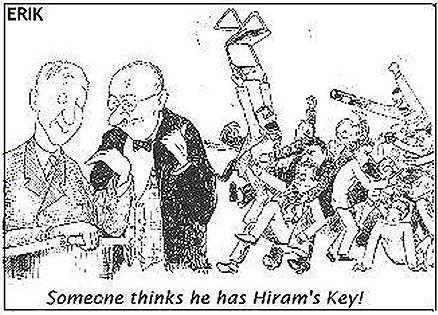 |
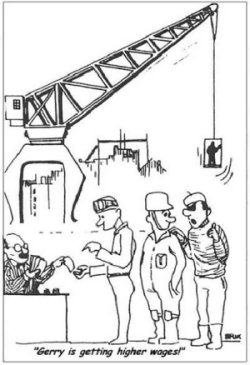 | |
 |
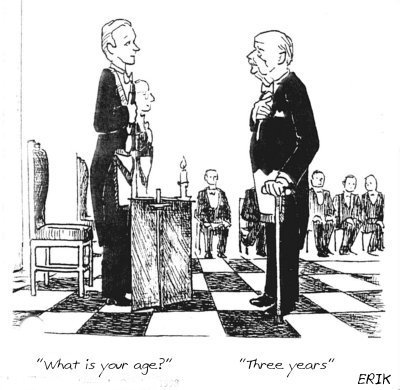
| |
Under this new law, Masonic Lodges can legally hold raffles. However , Lodges which have raffles must comply with all of the applicable laws and regulations (State and Local). The Civil Law Committee will revise the Grand Lodge laws to comply with this legislation.
The minimum requirements for charitable raffles as set forth in Chapter 2002 of the Texas Occupations Code are:
2. All proceeds from the sale of charitable tickets must be spent for the charitable purpose of the organization;
3. There can be no paid advertising to promote the raffle, i.e., television, radio, or newspaper;
4. There can be no statewide raffles;
5. There can be no offers to sell raffle tickets for a statewide raffle;
6. There can be no compensation to any person for directly or indirectly organizing or conducting a raffle or for selling or offering to sell tickets to a raffle;
7. Only members of the non-profit organization can sell raffle tickets;
8. Each raffle ticket must contain the name of the organization conducting the raffle; the address of the organization or of a named officer of the organization; the ticket price; and a general description of each prize having a value of more than $10.00;
9. A prize offered may not be money;
10. A prize may not exceed $50,000.00 in value;
11. A prize may not consist of one or more lottery tickets;
12. A prize has to be in the possession of the organization, or the organization must post a bond with the county clerk in which the raffle is to be held.
Additional information as to the legal aspects of "Charitable Raffles" can be downloaded from the Texas Attorney General's Office at www.oag.state.tx.us | ||
|
Page XI | |||
TIME: You joined the Freemasons in 2001. What made you want to get involved?
Kinney: I had been interested since the '70s, when I saw a few books about Masonry and had a lot of confusion about it. Around 2000, I said, Why not try it myself?
Masons aren't allowed to recruit people. Why is that?
They don't want you to bring in people against their will. They need to join for their own voluntary reasons.
So what are the basic requirements? Who can join?
You are given an application form to fill out, that's the first thing. You have to be male. The questions include "Do you believe in a supreme being?" It doesn't specify one particular religion, but because of the way the rituals have evolved, it's assumed a Mason is going to have a non-specific belief in a God or deity. It also asks if you've ever been convicted of a serious crime. That is a deal breaker. The main other thing is they want confirmation that you're self-supporting, that you're not joining the Masons to mooch off the lodge.
What was your initiation like?
When I showed up, I was put in a little preparation room beforehand that had some clothing that I was supposed to put on, and then they gave me a blindfold. The "obligation," or oath, is done at the altar in the middle of the lodge room. It's basically just a waist-high piece of furniture that has a Bible or whatever sacred text the individual has for their particular religion. Then you're walked around the lodge room, introduced to each of the main officers. You see the assembled brethren and the master of the lodge before you in his top hat. It's very traditional, early-1800s garb. And after the ritual — and this is true of all the Masonic degrees — the master recites a lecture on the group's history and symbols, memorized word for word. Those haven't changed in 200 years.
I imagine that would be a bit difficult to follow.
The language is a bit antiquated. It's almost like time travel. You realize this is almost exactly what was being done 200 years ago.
In the book's introduction, you mention how you omitted certain details.
The consensus seemed to be that the specific means Masons use to recognize each other — handshakes, the specific wording of parts of the ritual — should not be divulged. You don't want some fake Mason coming to your lodge and talking their way into your meetings.
You note that one of the darkest episodes in Masonic history led to the first-ever third U.S. political party, the Anti-Masonic Party. How did that come about?
There was a man named William Morgan who was — and there's some controversy about this — a disaffected Mason who decided to write a book on Masonic degrees. This was in 1826 in upstate New York, the frontier at the time. He was kidnapped and was never heard from after that. It appears that it was a group of Masons who abducted him. And because he was never seen again, it is possible to imagine all sorts of things that might have happened. So the reputation of Masonry took a real beating because [the incident] sort of seemed to prove people's theories — "Masons are going to kill anybody who reveals their secrets."
How did the members of your lodge react when you told them you were writing a book?
I didn't really go out of my way to publicize that I was doing it because I didn't want any undue attention. I didn't want people saying "Write about this" or "Don't write about this." I did discuss the book with a few people from my lodge, and while I was writing it, I had a number of Masons look it over to make sure I wasn't putting my foot in my mouth.
Some of the more persistent rumors about Freemasons include the notion that they're successors to the medieval Knights of Templar, that they're trying to create a New World Order and that they use symbols to communicate ancient wisdom. What was the most surprising thing you found?
That lodges are learning how to get by with fewer members and fewer resources. There was a certain cachet in ages past. But the overall membership has really been aging. There's a real attrition rate now. If it's going to survive at all, it has to turn that around.
So if Freemasons aren't busy running the world, what exactly is it that they do?
The outer mission is to be of service to the greater community, donating to charities and Masonic youth groups, like the Order of DeMolay for boys and Rainbow Girls, which encourage kids to be good citizens and give them social circles that are supervised by adults and are more positive than hanging out on street corners. The organization is also based on a kind of stoic philosophy, to become the master of your own passions — don't fall prey to your emotions, to anger — and to have a sort of balanced perspective on life.
There's also a set phrase: "We're in the business of taking good men and making them better." I don't particularly care for that slogan. I mean, how do you make them better? | |||
|
Page XII | ||
By Michael Keene Rochester Crime History Examiner (Editor's note; It seems that the author is saying, Ask and you shall receive!)
1. What is the ritual of the entrance ceremony? The first stage or degree of entering into Freemasonry is that of "Entered Apprentice." Each jurisdiction, or branch, of Masonic lodge is free to set their own ceremonial rituals within certain parameters. The initiation, they say, is an experience you will never forget. The beginning of the ceremony to become an Entered Apprentice includes a "hoodwink" covering, which is meant to symbolize the secrecy and privacy surrounding Freemasonry, and it also represents the ignorance of the "un"-initiated until such time as they begin their search for Truth within the boundaries of the Freemasonry fraternity. To know "all" their secrets, you will need to join and journey to the status of Master Mason. 2. What does the secret handshake mean? The Mason's secret handshake was meant to identify members among those who had not met before or who did not know each other. There was also a special hand "grip," and sometimes the use of a password. All these were done to say, "I am one with you" in the beliefs of the fraternity known as the Masons. 3. Is it a fraternity or a religion? Masonry has been described as a "fraternity within a fraternity." The outward appearance of the group known as the Masons has the goals of promoting a better community and society through good works. Others should take note that there is an inward "elite" group of brothers who toil unknown and attend to a higher path. Sometimes that "higher path" might lead into dark places before their higher plane is seen and recognized. 4. Are the Masons Christian-based or cult-based? Masons want you to believe that God and the Bible are important parts of Freemasonry. The Bible is laid open on every altar of every Masonic lodge and the oaths taken by new members are done so with the aid of the Bible to give their statements weight and lend credulity to their words. The Masons believe in accepting men of all faiths, no matter by what name they call God, or the Divine One. They know the "One" that is considered the supreme deity, called by another name, is still the same God. However, there are some acts believed to have been perpetrated by Masons that would lead one to believe they are not all freewill and goodness. One such story, detailed in "The Strange Disappearance of Captain William Morgan," tells the tale of how Mr. Morgan was kidnapped by a group of Freemasons and then murdered because he was going to publish a book revealing the secret workings of the "inner society" of Freemasonry. 5. Are Masons a "Secret Society," or do their actions and feelings just defy words to explain them? The Masonic Information Center will tell you that, if the Masons are supposed to be a "Secret Society," then it would be the "worst-kept secret in the world." In the late 1800s and early 1900s, secret societies became very popular and some of them were modeled after the Masons. The Masonic Information Center will go as far as to tell you that didn't necessarily make the Masons one of them. The Masons have lapel pins, rings, and tie clasps to indicate their affiliation. Linking the name of their organization with "secrets" may have to do with the fact that the overwhelming joy of satisfaction they feel with the accomplishments of goodwill of their group may be just too good to put into words.
The Masons would like you to believe they have no real secrets, but . . . is that just want they want you to believe or is it the truth? The answer to that is still a mystery. It is likely to remain a mystery until such time as you decide to journey down the path that will lead you to the inner workings and society of the Masons, and there you can decide for yourself.
| ||
A Book Review From The Bangkok Post In Bangkok, Thailand
By Laurence Gardner 456 pp, 2006
Freemasons will allow secrets (its handshake, coded expressions of identification), but otherwise claim to be transparent in its integrity, honesty, feelings of brotherhood. Far from ill-intentions, its focus is doing charity work for needy schools. Laurence Gardner specialises in penning books presenting exhaustively researched facts, to set us straight regarding things about which we have hazy and usually wrong ideas.
In the past he's written about the Holy Grail, Mary Magdalene, the Sacred Ark. This time round, in The Shadow of Solomon, the Freemasons. It has colour plates, illustrations, a bibliography, an index. His works appeal to scholars and readers interested in the subject matter. Those looking to be entertained, with historical tidbits thrown in, will find this 456-page tome rather heavy-going.
Viewers of the National Treasure come away with the notion that the Freemasons have centuries-old valuables waiting to be found. According to Gardner there is a treasure, but not of the sort we think. Rather it was the discoveries by the ancients, which didn't survive the ravages of time. The Bible and Medieval manuscripts allude to them.
Chronologically and through flashbacks, we are told about Freemasonry through the ages. The author leads us via etymology to the origin of words and their subsequent changes of meaning; what each Freemason symbol stands for; how the Catholic Church, Anglican Church, kings and queens of England, Scotland and France destroyed virtually all their documents.
They were into alchemy and quite possibly found the Philosophers Stone, turning base metals into gold. Gardner tries to persuade us that the Ark of the Covenant (Steven Spielberg's Lost Ark) was the forerunner of electricity. He suggests that way back when they had solved the mystery of levitation.
It is no exaggeration to say that just about every intellect in history was a Freemason. We are asked whether there isn't something more substantial than its devotion to good works that's attracted them. It isn't a religion - God is the Great Architect of the Universe - yet it has a metaphysical appeal. Isaac Newton, a member, stated that King Solomon who built the Temple of Jerusalem, was the greatest philosopher of them all.
The bottom line of The Shadow of Solomon is that, be it the Knights Templars or P2, the Freemasons have had an undeserved bad press. The author, to the extent possible, counters this. He admits that he had been a Freemason, but resigned to demonstrate that he's impartial. |
|
Page XIII | ||||
|
By David Montgomery & Monica Hesse
You know why we're here. Six years after his blockbuster "The DaVinci Code," Dan Brown's next novel, "The Lost Symbol," will hit stores Tuesday with a massive print run of 5 million copies. The book's contents remain a secret deeper than the whereabouts of the Holy Grail and the location of Christ's genome, but the cover shows a blood-red Masonic seal and the sun glinting behind the Capitol dome.
Hmmm. Masons, Washington. Washington, Masons . . .
Of course, Brown began dropping clues when he hid the "widow's son" phrase on the dust jacket of "The
Da Vinci Code" to allude to his next novel: Masons. There he also disguised an allusion to the enigmatic
sculpture Kryptos at CIA headquarters: Washington. There's nothing the author likes better than a secretive
society to help weave plots dense with coded knowledge that could change the course of history. So
Brown could have predicted this moment. He must have imagined we'd be taking crash courses on Masonry,
poised to scour the nation's capital for symbols and deeper meaning, following the footsteps of
Robert Langdon -- the author's tweedy Harvard symbologist hero, who's back in the new novel.
Does the layout of Washington reveal some hidden Masonic influence? Are those secret signs hidden in the
construction of key buildings? And what about those scary symbols on the nation's currency? Let's find
out. Touring Brown-inspired Washington Masonry before the novel even comes out may sound crazy, but
others have tried. Masonic historians such as S Brent Morris ("The Complete Idiot's Guide to Freemasonry")
and Christopher Hodapp ("Solomon's Builders") have proposed essential Masonic Washington sites to visit.
Old Town Trolley Tours is mulling the launch of a Secret Symbols tour of DC, based on a concept and 50-
page script drafted by Washington writer Warren Getler. Hollywood producers Ron Ziskin and Mark Victor
have made a two-hour documentary, "Hunting the Lost Symbol," to air next month on the Discovery Channel.
And journalist David A Shugarts published "Secrets of the Widow's Son," foretelling the Masonic Washington
theme, four years before "The Lost Symbol" reached bookstores.
So, all aboard.
1. The Temple of the Supreme Council of the 33rd and Last Degree of the Ancient and Accepted
Scottish Rite of Freemasonry for the Southern Jurisdiction of the United States Or House of the
Temple, for short.
Here comes Morris, the genial managing editor of the Scottish Rite Journal. "You can't have a building like
this without a cool door like this!" he says as, with a flourish, he pushes against a section of the limestone
wall. A hidden door swings open. Ah! The chamber of deepest secrets, we presume? "No, roof access,"
Morris says. "This is where we go to watch fireworks displays." Darn.
The Masons are cagey about their rituals, but otherwise they don't seem all that secretive. Docents give
free tours of the temple. Let's pause for some Masonry 101.
Masons first appeared in Britain in the early 1400s as members of craft guilds. Their "secrets" included how
to square a corner and build a cathedral. Claims of a connection to the Crusades and the Knights Templar -
- as suggested in "The DaVinci Code" and the "National Treasure" movies -- are the stuff of fable, historians
say. In the 1600s, non-stoneworking gentlemen began joining, and Masonry became fashionable. The Masons
encouraged free thought and religious tolerance.
They helped invent America: George Washington, Ben Franklin, nine signers of the Declaration of Independence
and 13 signers of the Constitution were Masons. Both Presidents Roosevelt and 11 other presidents besides
Washington were, too. Also J Edgar Hoover, Will Rogers, Ty Cobb, John Wayne.
For the roughly 1.5 million Masons in the United States today, Masonic life involves socializing, selfimprovement
and raising hundreds of millions of dollars a year for charity, Masonic leaders say. But you only
have to visit any number of anti-Masonic Web sites to find the darker claims of conspiracies to rule the world
and undermine religion. A persistent rumor involves secret symbols in the map of the city.
2. The L'Enfant Street Plan
Another consisted of five pairs of numbers, which turned out to be the latitude and longitude for the White
House, Washington Circle, Dupont Circle, Logan Circle and Mount Vernon Square. Draw lines on the avenues
connecting the points (pretend Rhode Island doesn't stop at Connecticut) and you get a five-pointed star.
For years Masons have wasted a lot of breath pointing out that five-pointed stars may be demonic, but they
aren't particularly Masonic. But wait: It's also possible to divine a six-pointed star on the map east of the
Capitol; and a square-and-compass centered on the Capitol. Those are Masonic symbols. Busted!?
A couple of problems: Pierre L'Enfant, who conceived the street design in 1791, was not a Mason, nor was
Andrew Ellicott, who executed the layout.
L'Enfant's guiding design principle was to symbolize the democracy by locating the White House and the Capitol
on two prominent rises, connecting them with a grand boulevard. The street scheme grew from that. "So
many of the claims are so ridiculous," says Don Alexander Hawkins, an architect and historical cartographer,
who debunks the conspiracy theories in a forthcoming essay for Washington History magazine.
On the other hand, Hawkins must admit, the boss who wanted the 10-mile-square city staked out exactly
here was George Washington, the Mason. Brown could work with that.
Did we mention that 16th Street is Washington's "Rose Line"? Brown loves a Rose Line, as readers of "The
DaVinci Code" know. A Rose Line, in Brown's fiction, is a meridian line with mystical significance. Thomas
Jefferson (not a Mason) conceived that 16th Street would be the prime meridian for the new world. The
meridian line would pass through the White House. He imagined that a monument to George Washington
would be placed on the spot where the meridian line intersected a straight line drawn west from the US
Capitol. Unfortunately, the Washington Monument had to be located slightly off the Rose Line where the
ground was firmer.
|
|
Page XIV | ||||||||
Continued From Page XII Continue the intersecting line from the Capitol across the Potomac River and you hit a place called Rosslyn, which, as "Code" readers know, is also the name of the sacred Templar chapel in Scotland. According to Brown's fiction, Rosslyn and Rose Line are linguistically connected: Rosslyn-Roslin-Rose Line. So the Masonic headquarters -- built more than a century after L'Enfant went to work -- is on Washington's Rose Line. And at the foot of the Rose Line, in Lafayette Park, the key statues depict Masons, according to Hodapp: Andrew Jackson, Lafayette, Kosciusko, Von Steuben and Rochambeau. This novel is just writing itself. 3. Statue of Albert Pike
His big, bearded likeness is almost lost in the canopy of trees. At his feet is a woman holding a banner with the double-headed eagle, the triangle and the number 33. The 33 is a specific reference to the Scottish Rite. Most Masons are not Scottish Rite. Washington wasn't. The Scottish Rite was founded in 1801 -- two years after Washington died, a decade after the city was laid out. Is Brown imagining a fateful schism among American Masons? At a book event shortly after "The Da Vinci Code" came out, Getler says he mentioned to Brown that his own recent nonfiction book, "Rebel Gold," concerned a secret society, buried treasure and Pike. According to Getler, Brown said: "I don't think I should read your book right now. My next book is about Albert Pike." 4. The Capitol
For conspiracy theorists and fiction writers, it could be special, too. Were his loyalties divided? In his novels, Brown reveres art as a system for communicating secret messages to the initiated. The Capitol, as essentially a massive national art gallery, may have something to say. High on the Capitol Rotunda's domed ceiling is Brumidi's dramatic portrayal of the "Apotheosis of Washington" -- the Mason ascending to heaven. Of 100 or so statues in Statuary Hall and elsewhere in the building, Hodapp counts at least 30 Masons. And he found a panel on the doors of the Senate depicting the cornerstone ceremony, Washington wearing his apron. (Speaking of official and quasi-official art, what's the deal with the Great Seal? On the back is an unfinished pyramid topped by the all-seeing eye, as on the back of a $1 bill. Masonic, right? No, says Morris. The final seal design came from a committee of non-Masons. The unfinished pyramid is not Masonic. The all-seeing eye is a Masonic symbol for the creator, but is used beyond Masonry as well, he says.) Brown also loves a crypt. There's one in the Capitol, of course, beneath the Rotunda. At the center of the crypt is a star. The star marks the spot from which the capital's four quadrants of streets fan out -- the very heart of the L'Enfant street plan with its mysterious meanings. What else is down there? 5. George Washington Masonic National Memorial
The tall lighthouse-like tower of the Masonic memorial dominates Alexandria. Inside is a gigantic bronze statue of Washington in his Masonic apron. It is also the modern home of a still-active Alexandria Masonic Lodge, where Washington was once the worshipful master. Also in Alexandria is Jones Point, where in 1791, during yet another Masonic ceremony, the first stone marking the outline of the District of Columbia was laid. 6. Kryptos, Central Intelligence Agency, Langley The perfect Brownian object: A work of art that embodies secrecy and ciphers, designed to adorn the headquarters of a spy agency. The public can't visit, but the agency has a little Web tour we can call up on our laptops. Created in 1990 by sculptor James Sanborn, the copper and stone Kryptos has four panels inscribed with letters, concealing four coded messages. Three have been solved. Still encrypted is a message with about 97 characters. What does it say?
Kryptos is seemingly a big step from the Masons -- unless WW stands for William Wirt, who ran on the Anti- Masonic Party ticket in 1832, and whose skull was supposedly stolen from his grave. The skull and bones were reunited by Smithsonian anthropologists. "Who stole William Wirt's skull?" was another pre-publication clue. Meanwhile, they are ransacking Washington for other coded art. Some say artist Albrecht Durer figured in a Twitter clue. "Lost Symbol" hunters say his "Melencolia" -- which is at the National Gallery of Art -- contains Mason-like symbols, even though Durer predated the Masons. "Melencolia" also contains a "magic square" -- a puzzle, believed to have mystical meaning, where rows of numbers add up to the same sum.
Prediction: Somewhere in "The Lost Symbol," a guy in a raincoat wearing a Masonic ring is going to be sitting on the Metro at the L'Enfant Plaza station working a very strange Sudoku puzzle. This can go on and on, which is what keeps us turning the pages, until it ends.
|
|
Page XV |
|
Reprinted With Permission Of The Author Brother Frederic Milliken - The BeeHive At Masonic Information
Those of us who have been in the trenches, involved with the daily operation of a Lodge and interaction with other Lodges and Brethren and with Grand Lodge have our eyes and ears open and we know what is going on. We see who is black balled and who is not. We notice the cultural and racial makeup of our Lodges, the Lodges around us and our Grand Lodge. WE KNOW WHAT IS GOING ON. For years now I have said that the KKK receded and disappeared into Freemasonry. They went underground with an organization from which they copied the style and manner of their ritual and the private manner of their organization. The KKK and Freemasonry have nothing in common philosophically but organizationally they are similar. So it was easy to just let Freemasonry absorb them. Now my hypothesis has been challenged by many Northern and Canadian Brethren who also have their eyes and ears open and don't see it – because it isn't there in their Lodges. Not experiencing it they just couldn't believe that it happens. They think that I am missing a few marbles, out to lunch, three french fries short of a Happy Meal. But if so why would the Grand Master of Virginia make this statement? Most Worshipful Jeffery E. Hodges wrote a letter with the following statement: “With regard to organizations that are anti-semantic, racist or antisocial in their doctrine and avocation, such as but not limited to, the Ku Klux Klan, Aryan Nations, etc., the following will be the policy of the Grand Lodge of Virginia: it is not acceptable to present information on, display association with, or solicit involvement in such organizations in a Masonic Lodge holden under the Grand Lodge of Virginia. At no time, should such organizations be linked to our gentle Craft.” There is a wonderful post by Brother Shelby L. Chandler on the blog for Gate City Lodge No. 2 which I have reprinted here below. It is worth noting and repeating one important point he made:
“As for that maligned Lodge mentioned above, all Masonic charges have been dropped. However, there is still a grassroots movement by other Lodges in their Grand Jurisdiction to petition to have the Charter of that Lodge removed as punishment for raising a Brother of “non-white” descent.” Here is the entire letter: · Do Good unto All We can let ourselves be torn apart by refusing to admit we have a problem. We can bury our heads in the sand, block our eyes, close our ears and just let life go on as it is. Or we can take arms against a sea of troubles and by opposing end them.
Fred
|
|
Page XVI | |
|
“Brother Jonas, it's been a long time since I was a Worshipful Master, so just call me Wesley or Brother Pennington if you need to use a title,” old Wesley Pennington said, “ OK, now, what kind of problem could a new Mason have with Masonry after only a few months?”
“Sorry, Brother Pennington, I forgot again.”
“It's OK, now what has you confused this time.”
“Well,” the young Brother said, “I can understand that many religious extremist dislike Freemasonry. What I don't understand is, if they are true Christians, why do they have resort to twisting the truth and even telling downright lies just to make their point. An excellent example was in a recent posting on The OpEdNews.Com, entitled L.A. Police Chief William Bratton: Admitted Freemason”.
“The author started with the following condemnation, 'This should be of concern, or at the very least noted, by anyone who appreciates open and transparent government. Freemasonry has a long and sordid history of subterfuge, murder and occultism. As a Catholic and liberty advocate, I am well aware, as all Catholics should be, of the church's teaching on this matter throughout the centuries.'”
“I know Brother Jonas I saw that story too. When I read the part that said Freemasonry has a long and sordid history of subterfuge, murder and occultism. I ran a Yahoo search on the internet for 'Murders by Freemason' and found an accusation (never proven) that Masons had killed Captain Morgan and an accusation (never proven) that Jack the Ripper may have been a Freemason.”
“Then just for the heck of it,” Brother Wesley continued, ”I ran a Yahoo search for 'Murders by Catholics'. The fourth item on the list was the Catholic Inquisition. It states that in the Spanish Inquisition alone, over a three hundred year period, thousands and thousands of "unrepentant" heretics were burned alive tied to a stake. And, then there were thousands of others who were murdered in the European and English Inquisitions”.
“Then I checked a Catholic website (http://www.catholic.com/library/Inquisition.asp) regarding the Inquisition. It stated, 'Sooner or later, any discussion of apologetics with Fundamentalists will address the Inquisition. To non-Catholics it is a scandal; to Catholics, an embarrassment; to both, a confusion.' So, the possibility that less than 10 members of Freemasonry, out of the millions, may have killed less than 10 people is the author's (or Catholicism's) reason to condemn the whole Masonic fraternity as murderers. But, having Catholic Priests killing thousands of people and arresting and torturing tens of thousands because they didn't agree with church dogma is only considered an embarrassment.”
“That seems to be the way it is,” the young Brother answered, “but I did get a big laugh out of the awful revelation the author claims to have discovered while visiting Waco, Texas. He said, they visited the site of the Branch Davidian Compound in Waco TX last summer, where 82 men women and children were slaughtered. Then he added, afterwards, I stopped by the Waco Masonic lodge, which is coincidentally right next to the police department.'
“You know,” Brother Jonas continued, after I read the part where the author quoted that workmen had dug up the remains of ten bodies hidden beneath the former London home of Benjamin Franklin and that the coroner had said he may have to hold an inquest, I looked up the story. It was called “Remains Of Ten Bodies At Ben Franklin's Home” in the Sunday Times |February 11, 1998. It seems the author left out the next two paragraphs in the story. They stated that the principal suspect in the mystery is Dr. William Hewson. Dr Hewson and Dr Hunter ran a school of anatomy in Soho, but after an argument, Dr Hewson left to live in Franklin's house, where he is believed to have established a rival school and lecture theatre and it was most likely that the bodies are anatomical specimens that Dr Hewson disposed of in his own house.”
“And another thing that gets me,” the new Brother said, “is how the Catholic Church condemns Freemasonry because they don't know secrets in the Lodge like the degrees new Mason must go through. However, the Fr. McCormick Council 3880 of the Knights of Columbus at Crystal Lake, IL has a web site at http://www.kofc3880.org/. It states, 'Let's clear up some misconceptions as well: We are not a secret society. Certain induction ceremonies are kept confidential in order to preserve the beauty and dignity of the lessons taught - namely - charity, unity, fraternity and patriotism.' So, the Catholic Church commends Masonry for doing exactly the same thing they do in the Catholic men's society.”
“Do you think Freemasonry and the Catholic Church will ever be able to resolve their differences?” the young Brother ask.
“Freemasonry has no differences with Catholicism. Any man who is a Catholic undoubtedly believes in God and if he meets our other requirements we welcome him as a Brother Freemason. The church leaders may never change,” Brother Jonas answered, “but some of the members do. We have 3 Masonic Lodge Brothers in this area who are Catholics. They work very hard for their Lodge and they do the same for their Church. One of them is even a member of the Knights of Columbus.” They discovered for themselves that there is absolutely nothing in Freemasonry that is against their Catholic religion.
I had no idea that Catholics would become Free masons," the young Brother answered, "that gives me hope that some day we will resolve our differences. Thanks a lot Worshipful for setting me straight."
"I am always glad to teach young Masons a lesson. Like the one now, where you can get me a fresh cup of coffee for calling me Worshipful again."
|
|
Page XVII | ||||
|
Novelist Dan Brown's new book, The Lost Symbol, is doing for the Freemasons what its predecessor, The Da Vinci Code, did for the Catholic Church's Opus Dei—showering new fame, and new fictions, on a brotherhood that's already catnip for conspiracy theorists.
Since long before The Lost Symbol, Freemasons have been accused of everything from conspiring with extraterrestrials to practicing sexual deviancy to engaging in occult rituals to running the world—or trying to end it. Detractors include global conspiracy theorists and religious organizations, including the Catholic Church.
Released today, The Lost Symbol isn't likely to squelch any rumors, beginning as it does with a wine-filled skull, bejeweled power brokers, and a dark Masonic temple steps away from the White House.
But what if Freemasons—the world's largest international secret society—are just a bunch of guys into socializing, non-satanic rituals, self-improvement, and community service?
To separate Freemason fact from Lost Symbol-style myth, National Geographic News went inside the centuries-old order with two Masons and a historian of the ancient Christian order from which some claim the Masons sprang in the 17th or 18th century.
FREEMASON MYTH 1
"I view the Masonic use of symbols as a grab bag taken from here, there, and everywhere," he said. "Masonry employs them in its own fashion."
The pentagram, for example, is much older than Freemasonry and acquired its occult overtones only in the 19th and 20th centuries, hundreds of years after the Masons had adopted the symbol.
Likewise, the all-seeing eye saw its way to the Great Seal—and the U.S. dollar bill—by way of artist Pierre Du Simitiere, a non-Mason.
The eye represents divine guidance of the U.S. ship of state, or as Secretary of the U.S. Congress Charles Thompson put it in 1782, it alludes "to the many signal interpositions of providence in favour of the American cause."
There was one known Mason on the committee to design the seal, Benjamin Franklin. His proposed design was eyeless, and rejected.
FREEMASON MYTH 2
After modern Masonry appeared in the 17th- or 18th-century Britain, some Freemasons claimed to have acquired the secrets of the Templars and adopted Templar symbols and terminology—naming certain levels of Masonic hierarchy after Templar "degrees," for example.
"But those [Knights Templar] degrees and Masonic orders had no historic connection with the original Knights Templar," Kinney explained.
"These are myths or symbolic figures that were used by the Masons. But because the association had been made with these degrees, and the degrees had perpetuated themselves, after a time it began to look like there had been a connection."
Helen Nicholson, author of The Knights Templar: A New History, agrees that there is no possibility that Freemasons are somehow descended from the Knights Templar.
By the time of the first Masons, the Cardiff University historian said, "there were no more Templars."
FREEMASON MYTH 3
The treasure, and the Templar tradition, were eventually passed down to the founders of Freemasonry, the story goes.
In fact, there was Templar treasure, Nicholson said, but it ended up in other hands long ago.
"The most likely reason [the Templars were dissolved] is that the king wanted their money. The King of France was bankrupt, and the Templars had lots of ready cash."
FREEMASON MYTH 4
The Lost Symbol is expected to prominently feature "Masonic mapping," detecting pentagrams and other symbols by connecting the dots among landmarks. Pre-release clues released by author Dan Brown, for example, include GPS coordinates for Washington landmarks.
"Individually, Masons had a role in building the White House, in building and designing Washington, D.C.," said Mark Tabbert, director of collections at the George Washington Masonic Memorial in Alexandria, Virginia. "And [small scale] Masonic symbols can be found throughout the city, as they can in most U.S. cities."
But there's no Masonic message in the city's street plan, Tabbert said. For starters, Pierre L'Enfant wasn't a Mason.
And, Tabbert asked, why would Masons go to the trouble of laying out a street grid to match their symbols?
"There has to be a [reason] for doing such a thing," said Tabbert, himself a Mason. "Dan Brown will find one, because he writes fiction. But there isn't one."
|
|
Page XVIII | ||||
|
Continued From Page XVII
FREEMASON MYTH 5 Freemasons Rule the World
"I think the ideals that Masonry embodies, which have to do with universal brotherhood, are shared by Masons around the world [regardless of] religious, political, or national differences," he said. "But having shared ideals is one thing—having some sort of shared hierarchy is something else altogether." Kinney noted that the U.S. alone has 51 grand lodges, one for each state and the District of Columbia. Each of these largely independent organizations oversees its many local blue (or beginner) lodges and has little real coordination with other grand lodges. Internationally, Masonic lodges not only don't speak with a single voice but sometimes refuse to even recognize each other's existence. Also, many Masons are independent minded and tend to resist edicts from above, Kinney said. "There is no way that they could be run by a single hierarchy. There is no such entity."
FREEMASON MYTH 6
Even so, to be accepted into Freemasonry, initiates must believe in a god—any god. Christians may be in the majority, but Jews, Muslims, and others are well represented in Masonic circles. At lodge meetings religious discussion is traditionally taboo, Kinney and Tabbert said. But some religious leaders believe that Masonic rituals and beliefs—with its temples, altars, and oaths—do constitute an opposing faith. And the Masonic refusal to rank one religion above the others hasn't always been popular. A 1983 Catholic declaration approved by Pope John Paul II, for example, said that "Catholics enrolled in Masonic associations are involved in serious sin and may not approach Holy Communion."
FREEMASON MYTH 7
But Freemasonry—born in Britain, after all—had adherents on both sides of the conflict. Tabbert, of the George Washington Masonic Memorial, said Masonic groups allowed men on both sides of the revolution to come together as brothers—not to promote a political view, which would be against Masonic tradition. "For many years [Masons] claimed in their own quasi-scholarship that all of these revolutionaries and Founding Fathers were Freemasons," Tabbert said. "A fair number of them were, but they weren't doing these things because they were Freemasons."
FREEMASON MYTH 8
When Freemasonry hit its peak in the U.S. during the late 1950s, Kinney, the Masonic historian, said, almost one of every ten eligible adult males was a member—a total of some four million and hardly a tiny elite. Today membership numbers, like those of other fraternal organizations, have declined dramatically, and only about 1.5 million U.S. men are Masons.
But with The Lost Symbol already igniting interest in Freemasonry, Masonic centers are bracing for tourists—and maybe a few new recruits.
|
|
Page XIX | ||||||||||
|
Adds To Fraternal Order's Mystique. The Salt Lake Tribune
In Brown's telling, Masons represent the apex of religious tolerance and moral purity, free of sectarian infighting. They have, he suggests, been vilified by outsiders who are too conventional to understand the Masons' use of allegory, morality plays and symbols, their cohesion and fidelity and their grasp of eternal principles. "In a world where men do battle over whose definition of God is most accurate, I cannot adequately express the deep respect and admiration I feel toward an organization in which men of differing faiths are able to 'break bread together' in a bond of brotherhood, friendship and camaraderie," Brown wrote in a 6 October letter to the Masons of the Southern Jurisdiction. "Please accept my humble thanks for the noble example you set for humankind."
Legendary laborers Freemasonry is the world's "largest, oldest and best-known fraternal organization," according to an online essay published by the Masonic Society, headquartered in Indianapolis. Mythically linked to the builders of King Solomon's Temple in ancient Jerusalem, the group is believed to have emerged among Middle Age stonemasons who built castles and cathedrals. They lived in lodges near the building site, where they formed strong bonds. In a pre-literate society, they developed signs, handshakes and passwords to identify one another as they moved from town to town.
Each lodge, including the one on South Temple Street in Salt Lake City, boasts rooms meant to signify Solomon's temple. Sitting on the altar in the room's center is a Volume of Sacred Law, usually a Bible, but could be a Hindu Bagava Gita, Book of Mormon or Quran. Every room has a staircase, each step emblazoned with words such as hearing, seeing, feeling, smelling, tasting, grammar, rhetoric, logic, arithmetic, geometry , astronomy and music . Candidates climb the stairs to symbolize their increasing knowledge. The point is to provide a moral education through role playing, explains John Liley, senior grand warden of the Grand Lodge of Utah. "It's the original finishing school for men." In his 20s, Liley, whose uncle, grandfather and great-grandfather were Masons, joined the group because he was looking for that "elusive male bonding." He wanted a place where he could learn lofty principles as well as practical skills like public speaking. Now he is the group's spokesman and at ease before any audience.
There are three degrees, each named for a stage in the imagined professional development of a medieval stonemason: Entered Apprentice, Fellow Craft and Master Mason. At each level, there are ritual challenges and trials, the imparting of information and the testing of knowledge. "Pretty much everything -- the clothing, actions, words, placement of the officers, even the ceremonial walk around the lodge room -- has symbolic significance," Koltko-Rivera writes. The purpose, he says, is to elicit ethical behavior, including honesty, charity, benevolence and the giving of aid. And each ritual is protected by vows of secrecy. Masons agree not to divulge, for example, passwords and hand grips by which two brothers may confirm their mutual membership. They are aware of "bloodcurdling penalties for transgressing these obligations," Koltko- Rivera says, "but it is God who would carry out these penalties, not Masons themselves." Masons and the church
Masons provided a place where people of various faiths could meet safely; passwords and handshakes allowed them to identify fellow members. Though dominated by monarchies and the Roman Catholic Church, Europe also was awash in 18th-century Enlightenment ideas about reason, liberty and equality. It is no wonder Masons met in secret societies to discuss these radical notions, says Dan Burstein, author and editor of Secrets of the Lost Symbol , due out in December. It is no wonder that as many as 26 of 55 signers of the US Constitution, which incorporated so many of these ideas, reportedly were Freemasons. It also is not surprising that Christians, especially the Catholic Church, saw Masonry as the enemy. For starters, Masons swear allegiance to a Supreme Being, but do not have to be members of any particular faith nor believe in a particular deity. Some critics argued Masons essentially were Deists who believed in God, but little else.
|
|
Page XX | ||||
|
Adds To Fraternal Order's Mystique. Continued From Page XIX
"It was a real challenge to the church's powerful positions in society, Burstein says. "The Catholic Church declared it not possible for a Catholic to be a Mason."
Despite the book's flaws, Burstein applauds Brown for writing a book about ideas. The book's villain, Mal'akh, is a Mason who wants the final secret for himself and will do anything, even kill, to get it. "He is almost more devoted to Masonic rituals and ancient mysteries than the Masons who claim to be keepers of the secret," he says. "He represents the danger of religious fanaticism and excess."
To Burstein, Brown seems to be saying the closer we get to deep knowledge, the more dangerous that can be. And that is a cautionary tale for everyone, even without the symbolic clothing and secret passwords.
| ||||
|
Cindy Kahler Thomas
Editor Rural Lodge Newsletter: Brethren, You hold the resources and archives of your blue lodge in trust. It is the duty of the lodge to take care of artifacts which might well be irreplaceable. Consider donating your old records to a local museum where they can be stabilized and become available to future generations.
The painting had hung in a Masonic lodge since it was purchased by the lodge on 24 April 1927. It originally hung in the old Masonic lodge downtown. In 1955, when the new lodge opened on Kemp Boulevard, the portrait was hung there. The painting is titled “George Washington The Mason” and was painted by Peter Plotkin in 1921. It is 4 feet by 8 feet and depicts Washington with some classic Masonic symbols. It has been a long four years since the fundraising started for the refurbishment of the portrait in 2005. “There were several of us (Worshipful Masters or presidents of the lodge) that discussed the painting and that something had to be done about it,” Kirby Pacheco, past master of 2004-2005, said. Unfortunately, it had been hung incorrectly by the sides of the frame. Flash forward to 2005, and the painting sagged from its frame, because of the way it had been hung; it had holes that someone had attempted to repair, and it was cracked. Also for years, the members of the lodge had smoked in the meeting room where the painting hung and it had a coating of nicotine and dirt. It was in a sad state of repair. “Because I am artistically inclined, it killed me to do nothing. I felt like I had to do something,” Pacheco said. He started to pursue ways to raise money for the refurbishment. It was decided the lodge would have a George Washington dinner to raise funds. That first dinner raised approximately $600 in 2005. However, the estimated cost to refurbish it was between $7,000 and $8,000. The next two masters of the lodge did not make it a priority, but that changed last year when Ken Adair became Worshipful Master.
“We had been thinking about it for a long time, and every master wanted to do it, but Brother Adair was the one that finally did it,” said Charles Reeves, past master from 2003- 2004. Adair found the company that did the refurbishment in Dallas. “One of the pluses was that he finally found someone that the painting meant something to,” Reeves said, “We couldn't find anyone that even cared enough to do it.” In May of 2009, the funds had been raised, and a lot of research had been done to find the right art restorer. They chose Los Negras Painting and Refurbishment Art Studio in Dallas. George was given a going away dinner. The public was invited for a last look and for dinner, and the price of the tickets was added to the funds meant to refurbish it. Texas Masonic law states every Masonic lodge must have a portrait of George Washington. Washington was a mason and the only president who was master of a lodge while president. Pacheco got out his paint brushes and painted a portrait to replace the old painting, and to keep the lodge on the right side of that law. Flash forward to the present. “George Washington The Mason” is back home. This time his has been hung according the art refurbisher's instructions. He is sitting on a shelf and is connected to the wall only at the top. The shipping and refurbishing costs came to approximately$6,500. The portrait painted by Pacheco will find a new home. The Masonic lodge in Petrolia is making a donation toward the Faith Lodge's George Washington, and Pacheco is donating the portrait he painted to the Petrolia Masonic lodge. Again, the Masonic lodge had a George Washington dinner un October 24, 2009. The funds raised will help to replenish the fund that some of the cost came out of. |
|
|

